March 24, 2017
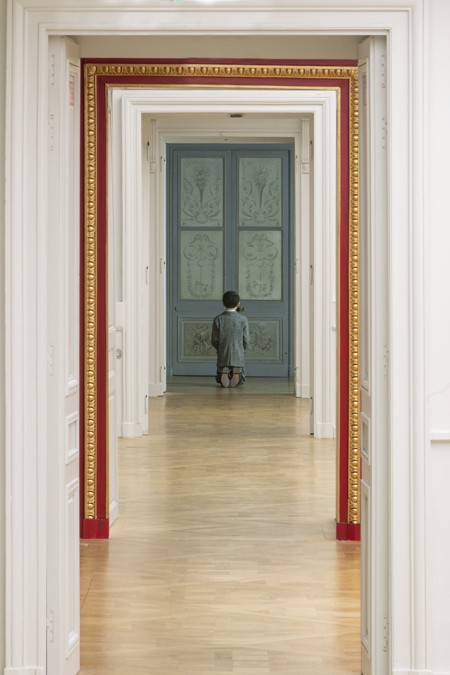 Multi-media sculptor Maurizio Cattelan is known for his conceptual prank art. He has taken things out of galleries instead of putting them in, dug holes in museum floors, used guards as pedalling exhibits and taped his Italian art dealer to the wall so he could merchandize himself. Cattelan has sent friends to impersonate him at interviews, he has even gone as far as stealing the works of other artists to sell them in a nearby gallery, taking appropriationism to a whole new level. In September 2016, Cattelan’s lavish Duchampian minimalism pushed him to replace one of the toilets in the New York Guggenheim with an 18-karat gold replica. He justified this approach in interview, arguing that “good taste is frightful, it’s the enemy of creativity.”
Multi-media sculptor Maurizio Cattelan is known for his conceptual prank art. He has taken things out of galleries instead of putting them in, dug holes in museum floors, used guards as pedalling exhibits and taped his Italian art dealer to the wall so he could merchandize himself. Cattelan has sent friends to impersonate him at interviews, he has even gone as far as stealing the works of other artists to sell them in a nearby gallery, taking appropriationism to a whole new level. In September 2016, Cattelan’s lavish Duchampian minimalism pushed him to replace one of the toilets in the New York Guggenheim with an 18-karat gold replica. He justified this approach in interview, arguing that “good taste is frightful, it’s the enemy of creativity.”
“Not Afraid of Love” at the Monnaie de Paris is Maurizio Cattelan’s first large-scale exhibition since Solomon R. Guggenheim’s “All” in 2011, after which he announced his retirement. Cattelan’s current Paris exhibition is no exception to his innovatory approach to the art of exhibiting. It both subverts the notion of artistic retirement and undermines the expectation that a new exhibition showcases new work. Cattelan succeeds in making his signature pieces look different by exhibiting them in a location that adds historical echoes, making them interact with each other in a thought-provoking manner. At the Monnaie de Paris, the work resonates unexpectedly the way a voice is amplified in a concert hall with exceptionally good acoustics.
From being a perspectivist who challenges habitual representations (one of the exhibits is a horse’s headless body protruding from a wall instead of the usual trophy head), Cattelan has also begun to engage in the art of self-perspective. His Guggenheim exhibition suspended the entire body of his work from the oculus of the museum’s rotunda, making his past works look radically altered, if a little hard to gauge.
Cattelan’s strength lies in his ability to prompt contradictory feelings about his works. He manages the strange balancing act of creating art that can be perceived as both profound and inane, simultaneously ethical and unethical, self-denigratingly self-promoting, transgressive and bland, original and derivative, tragic and comic. How can something be both one thing and its exact opposite? I’d like to argue that the viewer shouldn’t ultimately have to decide between warring impressions. Having a discerning mind doesn’t mean you have to stand in uncompromising judgment, dissolving the beauties of paradox. A work of art is the sum of all the reactions it elicits.
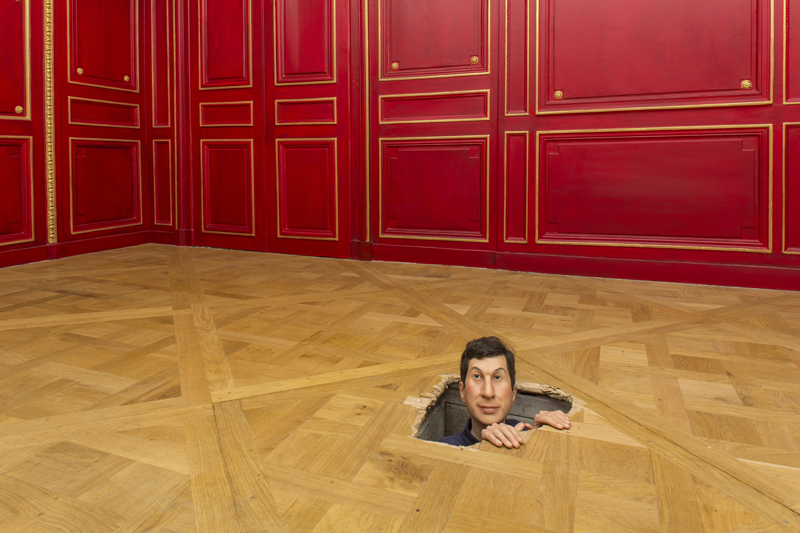
As soon as you enter the Monnaie de Paris you begin to realize why Cattelan chose to display his works in this palatial neoclassical edifice. Suspended by the midriff like a hooved and hairy chandelier above the grand staircase is Cattelan’s first taxidermied horse, a work conceived in the mid-1990s. An onslaught of responses besiege the mind as you tilt back your head to peer at it. You feel a sense of awe at the handling skills involved in suspension art on such a scale and the undeniable jokey joy in having a horse thus defamiliarized. But these are followed closely by the sensation that you are also witnessing somewhat facile ready-made Duchampian art (with a sharky nod to Damian Hirst): put anything in a museum (especially a murdered animal) and it is instantly transformed into profoundly conceptual art.
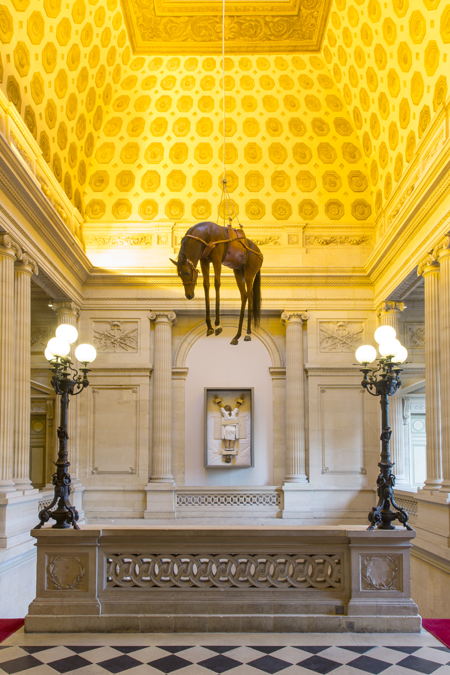 Even if you aren’t an animal activist it’s hard to suppress the feeling that this sculpture is a waste of a good horse. Isn’t there something slightly unethical about having a young equine vertebrate stuffed in the prime of its life? Depending on your perspective, it may not be as disturbing as experiencing a Gunther Von Hagens show of plastinated real human corpses, but it comes close enough. Surely Cattelan could have had a wax-work artist design a hyperrealistic horse instead of having recourse to taxidermy.
Even if you aren’t an animal activist it’s hard to suppress the feeling that this sculpture is a waste of a good horse. Isn’t there something slightly unethical about having a young equine vertebrate stuffed in the prime of its life? Depending on your perspective, it may not be as disturbing as experiencing a Gunther Von Hagens show of plastinated real human corpses, but it comes close enough. Surely Cattelan could have had a wax-work artist design a hyperrealistic horse instead of having recourse to taxidermy.
Nevertheless, when viewed as Cattelan’s take on the genre of the equestrian statue, the sculpture is undoubtedly original. The jelly-boned horse casts an ironic look at the obscenities of commemorative jingoism. Its title, Novecento, was inspired by the 1976 Bertolucci film set in Fascist Italy. The hanging floppy horse provides a striking deflation of the film’s recurring power symbol. Nevertheless, although art and ethics have admittedly always been uneasy bedfellows, Cattelan’s sculpture places an additional strain on an already fraught relationship: debunking Fascism by slaughtering a horse is ultimately a bit of an ideational contradiction.
The vast colonnaded galleria of the Salon d’Honneur features one of Cattelan’s major references to Christ’s Crucifixion, La Nona Ora (1999), “The Ninth Hour”, a sculpture of Pope John Paul II hit by a meteorite. It’s a work that Anthony Burgess might have enjoyed: despite his Catholic outlook, he took iconoclastic pleasure in juxtaposing archbishops and catamites. Is a meteorite more striking than a catamite? The Vatican certainly thought so, blacklisting La Nona Ora alongside other unorthodox religious artworks such as Andres Serrano’s Piss Christ (1987) and Chris Ofili’s elephant dung-coated Holy Virgin Mary (1996). Like these two artists, Cattelan has denied anti-Catholic intentions: “my idea was closer to that which brought me to expose safety deposit boxes, that is to say, to stage the contrast between power and vulnerability.” As an improbable form of divine punishment the work is a comic memento mori that nevertheless also implicitly seems to castigate the Pope for the Vatican’s various sins of omission, from lack of condom-support to silence in the face of fascism and paedophilia.
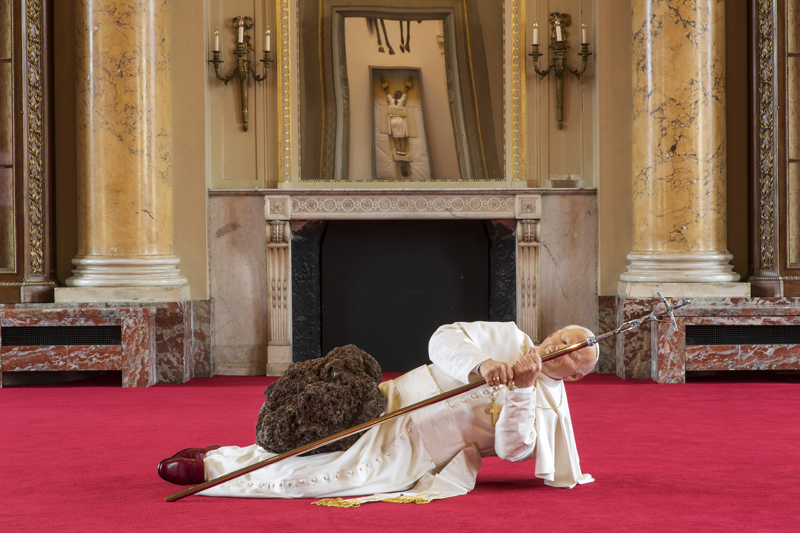
Perched on the mezzanine high above the Pope, Cattelan’s 2003 animatronic drummer boy (inspired by Günter Grass’s anti-Nazi novel The Tin Drum, 1959) provides an additional historical note of condemnation. Cattelan’s thoughtful use of space is complexified by placing the drummer boy on the railing of the mezzanine. This resourceful use of verticality is powerfully theatrical and serves to invoke the motif of suicide that underlies a significant number of Cattelan’s works. The temporal layering provided by the reference to Nazism is compounded by Cattelan’s decision to display the meteorite-stricken Pope in the very salon where George Balthazar Sage exhibited his edifying mineralogical collection in the late eighteenth century.
In an adjacent room, the artist’s untitled portrait sculpture of himself emerging from the ruptured floor also interacts interestingly with the features of the edifice. You can see the point of dramatizing this break-in self-portrait at the Paris Mint: as the oldest world institution still in operation (it was founded in 864), the Monnaie de Paris symbolizes the seat of governmental power and wealth. Cattelan’s heist scene is more than just that though: he has claimed that his original intention was to highlight his need “to get inside” things in general. Despite his humble origins, Cattelan has certainly gained access both to the art market and the immense atmospheric wealth of some of the most inspiring architecture.
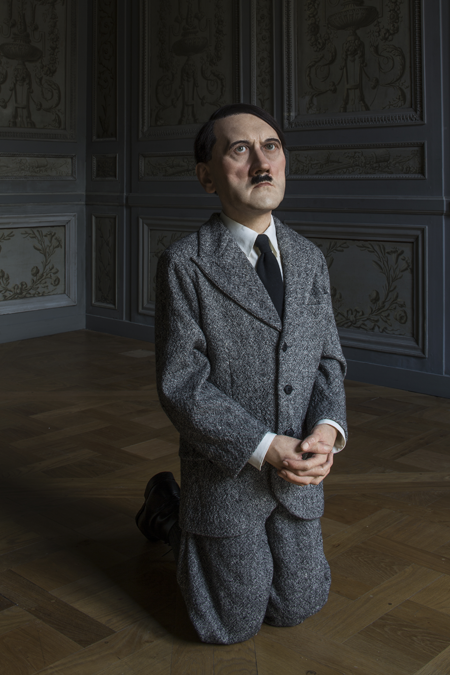 To complexify the break-in sculpture on this occasion, Cattelan installed a mirror which reflects the broken parquetry, thus emphasizing the theme of doubleness that permeates his oeuvre. He also had his initials discreetly embossed on the cornice in royal magenta lettering opposite a monogram of Napoleon’s name, thus imperially signing the room the way painters used to autograph their canvases.
To complexify the break-in sculpture on this occasion, Cattelan installed a mirror which reflects the broken parquetry, thus emphasizing the theme of doubleness that permeates his oeuvre. He also had his initials discreetly embossed on the cornice in royal magenta lettering opposite a monogram of Napoleon’s name, thus imperially signing the room the way painters used to autograph their canvases.
It is a characteristic of Cattelan’s art that it simultaneously belittles and aggrandizes. One of the focuses of this exhibition is self-portraiture, a feature that reinforces the strain of self-contemplation. There is a “Mini-Me” version of the artist gazing down at the viewer from the cornice next to the stuffed pigeons he made for the Venice Biennale, and scaled down doll-like doubles of himself in bed or hanging off a hook on the wall.
In the last room is Him (2001), a depiction of a kneeling child that you are forced to perceive from behind as you enter. The limited perspective leads you to expect innocence itself only to slap you in the face with its polar opposite. Circling the child, you discover it bears the features of Hitler’s penitent face. The perspectival trick heightens the horror of meeting Hitler in the flesh, but it also seems designed to make you reconsider Hitler in a more human light. The sculpture needs to be seen in situ rather than in a catalogue reproduction: moving up close to Him floods you with a surge of hatred and unforgiving pity for the human monster. It comes across as a fitting punishment to have Hitler pray for forgiveness - forever - with a contrite look in his eyes.
Cattelan may be an attention-seeking art-circuit jester, he is still an inventive and mind-goading artist. Up to the nineteenth century art generally epitomized the loftiest sentiments that artists had to offer; the twentieth century frequently examined the worst, most hideous human impulses. Cattelan’s art does both, offering a totalizing look at man: his depth, his silliness, his immoral-moral impulses, his tragicomic antics. Whatever one may feel about his art, it continues to challenge the show-goer, expanding the limits of minimalism, the emotional reach of hyperrealism, exploring the eye-opening possibilities of perspective.
Transcending Passages, Maisoon Al Saleh, March 16th - April 6th, 2021
Unbound Perspectives - SEPTEMBER 26-OCTOBER 17, 2020
East Villager Billy The Artist Climbs Atop Ai Wei Wei's Fence To Shine A Light On It
A Quick Note on Transplants: Greek Diaspora Artists
Teddy Thompson’s Ultimate Funeral Mix Tape
Accumulation: Sculptural work by Alben at Gallery Nines
Moray Hillary, Pre-New Reflective by Heather Zises
SELFISH, Review by Heather Zises
Winter Realm Series by Noah Becker
Paul Rousso at Lanoue Fine Art
Airan Kang, The Luminous Poem at Bryce Wolkowitz Gallery
Damien Hoar De Galvan at Carroll and Sons
Antigone, 2015, directed by Ivo van Hove
Karen Jerzyk's unsettling Parallel World
CEK - Concrete Functional Sculptures
Alexis Dahan, ALARM! At Two Rams
Do Ho Suh, Drawings, at Lehmann Maupin
Nir Hod, Once Everything Was Much Better Even the Future
Exhibition Review: Mario Schifano 1960 – 67
Subverting the Realist Impulse in the Work of Shauna Born
Linder: Femme/Objet by Erik Martiny
What We Do in the Shadows by Jemaine Clement and Taika Waititi
Justin Kimball at Carroll and Sons
Told & Foretold: The Cup in the Art of Samuel Bak, at Pucker Gallery
Collective Memory Manipulated: Sara Cwynar’s Flat Death
Art Paris Art Fair 2013 Review
Paris Street Art Musée de la Poste
Trellises by Katherine Tzu-Lan Mann
Topography of Destruction Kemper Museum
L'art en Guerre : France 1938-1947
The Louvre Relocates to Africa
A French Priest, Tears and Fire the Art of Jean-Michel Othoniel
